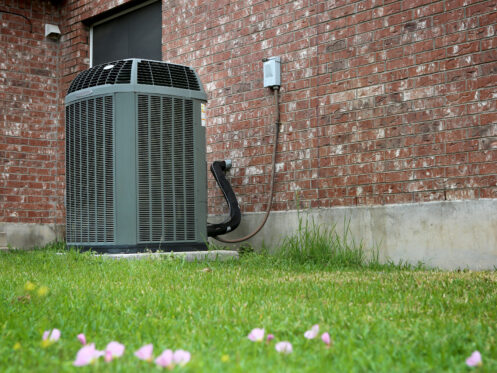Are you considering installing a heat pump but not sure if it’s the right choice for your home? The popularity of heat pumps is quickly skyrocketing, as they are extremely energy efficient and can provide both air conditioning and heating. Heat pump technology has also advanced rapidly in recent years, which has helped to make them much more effective at heating in cold weather than they once were. In this article, we’ll show you everything you should know about how heat pumps work and why installing one for your home can be such a great decision.
How a Heat Pump Provides Cooling
Heat pumps are very similar to a normal central air conditioner. Not only do the two units look virtually identical, but they also function the same way to keep a home cool. The most common misconception about air conditioning is that it just produces and pumps out cold air into the home, which technically isn’t true.
As with a standard central AC unit, a heat pump uses a special refrigerant chemical to draw heat energy out of the air inside the home and then release the heat outside. When the unit runs, it continuously pumps extremely cold refrigerant into the evaporator coil inside the HVAC air handler compartment in the home. At the same time, the HVAC blower constantly draws into the air handler via the return air vents and ductwork.
As the warm air hits the cold evaporator coil, the refrigerant naturally absorbs and draws much of the heat out of the air. This process causes the temperature of the air to decrease. The blower then moves the cool air around the home through the supply ductwork where it then blows out of all of the vents.
This process means that there is constantly cold refrigerant flowing into the home and hot refrigerant flowing back outside to the heat pump. When the hot refrigerant enters the heat pump, it flows through the unit’s compressor. As the refrigerant is compressed, its pressure increases and it instantly changes from a hot liquid into a superheated gas. When the refrigerant exits the compressor and flows into the evaporator coil, its temperature is usually somewhere between 120 and 140 degrees.
As the heat pump runs, its internal fan continuously pulls air in and blows it over the condenser coil. Since the refrigerant is now much hotter than the air, most of the heat it contains is instantly released into the air so that it quickly cools down. Finally, the refrigerant is pumped through an expansion valve, which decreases its pressure so that it again becomes extremely cold before being pumped back inside.
How Heat Pumps Provide Heating
The main advantage of choosing a heat pump over a traditional central AC unit is that a heat pump can run in reverse to supply heating to your home. The thing that sets heat pumps apart is that they have a special reversing valve that can activate and force the refrigerant to flow through the system in the opposite direction.
When a heat pump runs in heating mode, the heat transfer process is reversed so that extremely cold refrigerant captures heat from outside. The refrigerant is then compressed to instantly make it extremely hot before it’s pumped inside to the coil in the air handler. The blower then pulls cool air into the air handler, and the refrigerant releases all of its stored heat to instantly raise the air temperature and start warming up the home.
How Heat Pumps Work in Freezing Cold Temperatures
The one thing to understand is that the boiling point of refrigerant is extremely low. When the refrigerant moves through the expansion valve and its pressure increases, it instantly cools down to approximately -22 degrees Fahrenheit. This allows it to continually capture some heat energy from the outdoor air as long as the outdoor air temperature is above the temperature of the refrigerant.
The issue is that there is obviously less and less heat energy for the refrigerant to capture the colder the air temperature gets outside. This results in the effectiveness and energy efficiency of a heat pump slowly decreasing the colder it is outside. In extremely cold weather where the outdoor temperature is below the boiling point of the refrigerant, the heat transfer process would no longer work at all.
Even when the air temperature is well below freezing or even below zero, a heat pump can often still work effectively enough to maintain a consistent temperature inside as long as it runs continuously. The only problem is if the home is more than 5 or so degrees below the desired temperature. In this case, it could easily take well over an hour or more for a heat pump to warm the home up to temperature in below-freezing conditions.
This issue is why you need an auxiliary or backup heat source if you plan on heating a home in a colder climate with a heat pump. Any time it is too cold for the heat pump to work very effectively or if the home is colder and lots more heat is needed, the thermostat will automatically switch over to auxiliary heat. If you have an existing gas furnace, you can set it up so that the furnace functions as the auxiliary heating option. The other option is to install a cold-climate heat pump, as this type of unit comes with electric heating elements that serve as the auxiliary heat source.
The other reason that it’s necessary to have an auxiliary heat source is that a heat pump will always need to occasionally run its defrost cycle when heating in temperatures at or below 40 degrees. Depending on how cold it is, a heat pump will usually defrost anywhere from every 30 minutes to two hours. To defrost, the heat pump activates the reversing valve so that heated refrigerant flows through it to melt any ice that has formed on its coil and refrigerant lines.
Why Heat Pumps Are the Best Heating Option
Heat pumps are obviously a great investment since they mostly eliminate the need to have a separate air conditioning and heating system. Still, the main reason they’re such an excellent choice is that they tend to be anywhere from three to five times more energy efficient than even the very best furnace. If you only rarely have to rely on the auxiliary heat source, a heat pump has the potential to save you 60% or more in heating costs compared to any other option. Even if you had to rely on the auxiliary heat around half the time, a heat pump will still save you lots of money in the long run.
As the most trusted HVAC company in Norman and the OKC area, Norman Air is the one to turn to for all of your heating and air conditioning needs. Whether you’re looking to install a heat pump or need to have your HVAC system serviced or repaired, we’re always ready to help. We also offer the full range of residential electrical and plumbing services so give us a call and let our expert team take care of all of your home service needs.

